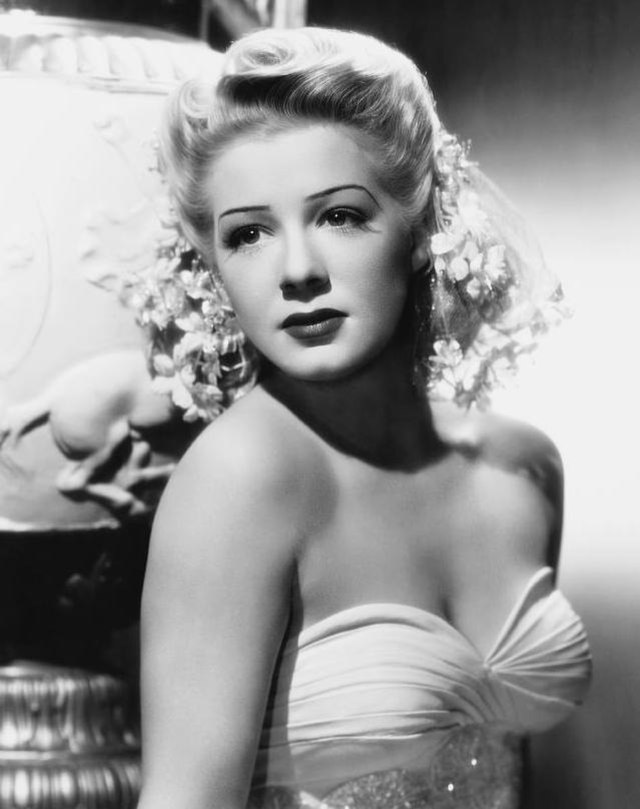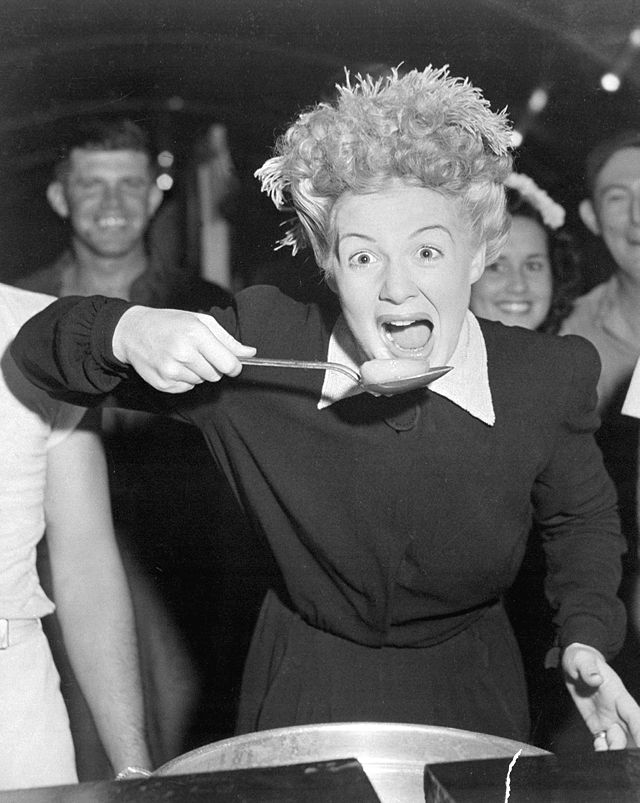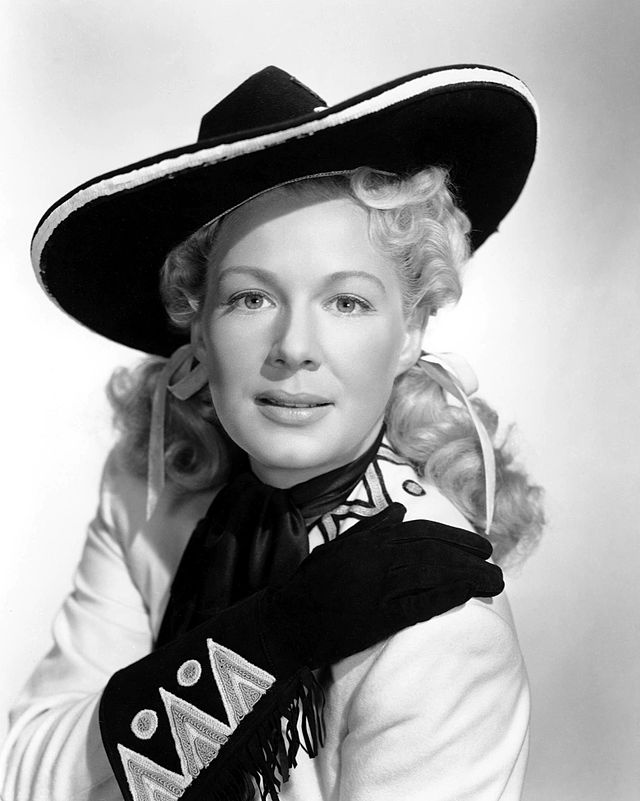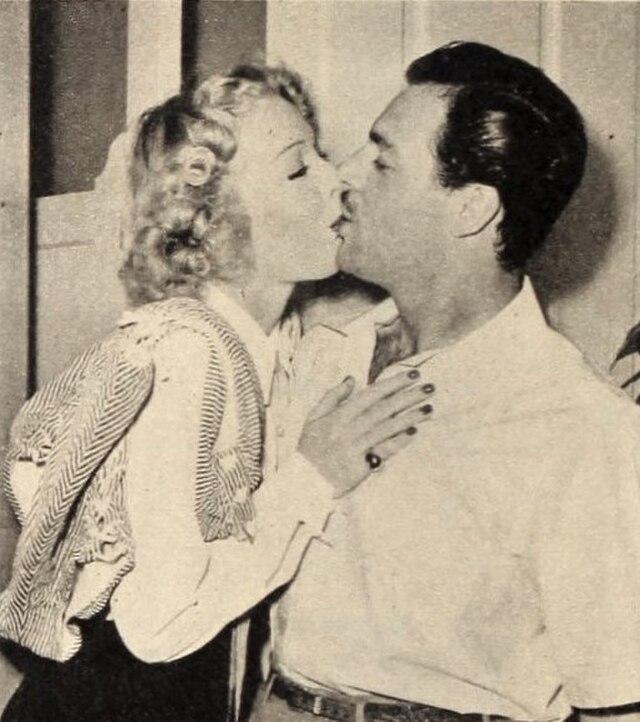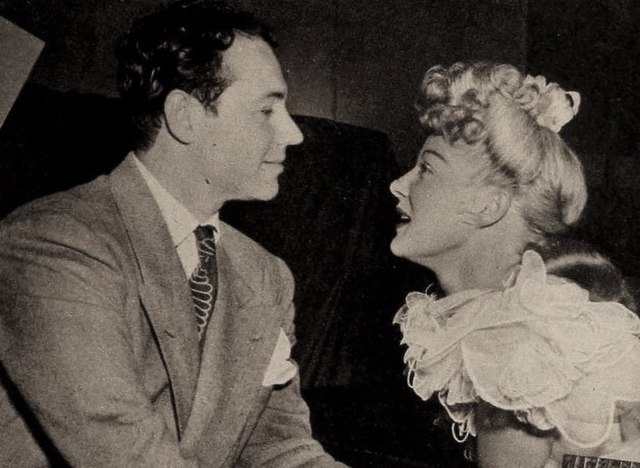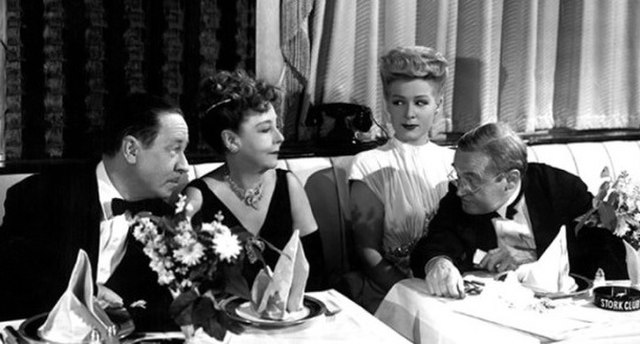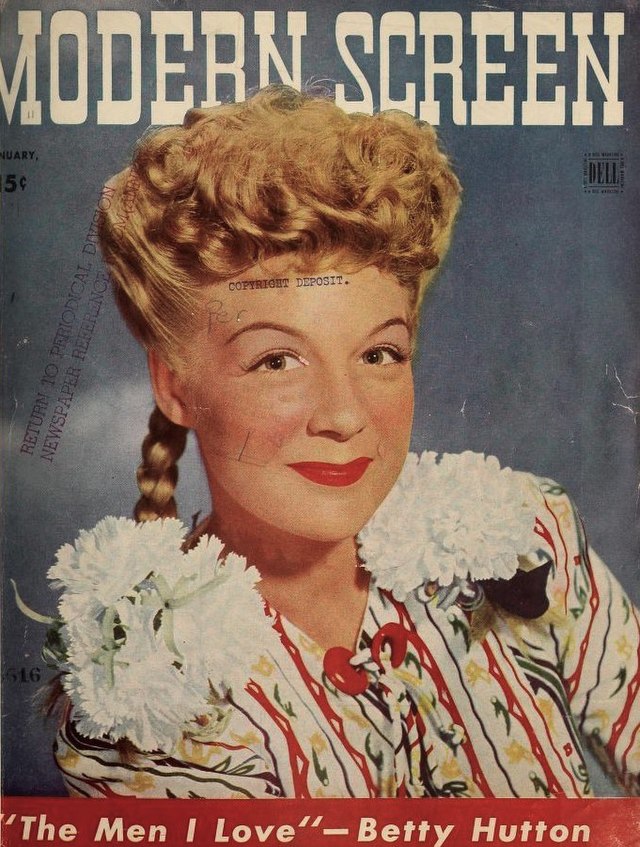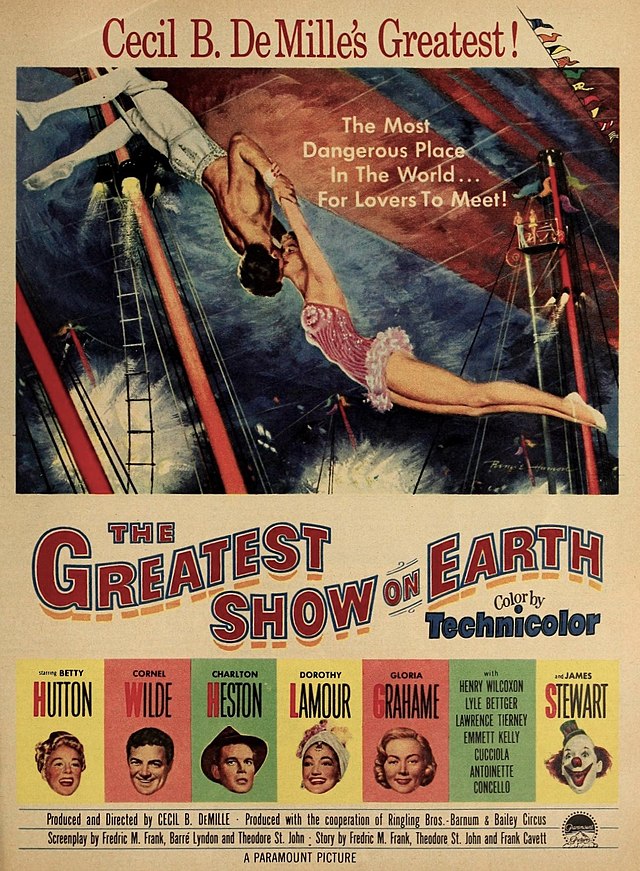Betty Hutton
back| Full Name | Elizabeth June Thornburg |
| Stage Name | Betty Hutton |
| Born | February 26, 1921 |
| Birthplace | Battle Creek, Michigan, USA |
| Died | March 11, 2007 |
| Buried | Desert Memorial Park, Cathedral City, California |
| Married to | Ted Briskin (1945–1950) - Charles O'Curran (1952–1955) - Alan W. Livingston (1955–1960) - Pete Candoli (1960–1967) |
| Children | 3 daughters: Candy, Lindsay, and Caroline |
| Notable films | Annie Get Your Gun (1950) - The Greatest Show on Earth (1952) -The Perils of Pauline (1947) - Let's Dance (1950) |
Betty Hutton
The Blonde Bombshell of Comedy
Betty Hutton (1921–2007) was a vibrant actress and singer, known for her boundless energy and comedic talent. Born in Michigan, she rose to fame in the 1940s with her brassy persona and musical prowess.
She starred in hit films like The Miracle of Morgan’s Creek (1944), Annie Get Your Gun (1950), and The Greatest Show on Earth (1952). Hutton was renowned for her dynamic musical performances and physical comedy, earning a Golden Globe nomination for Annie Get Your Gun.
Related
Betty Hutton (1921 – 2007)
A Remarkable Journey Through Hollywood
Early Years: From Struggle to Stardom
Betty Hutton, born Elizabeth June Thornburg on February 26, 1921, in Battle Creek, Michigan, came into the world during difficult times. Her father, a railroad foreman, abandoned the family when Betty was only two years old, leaving her mother, Mabel McNulty, to raise Betty and her older sister, Marion. Mabel struggled to make ends meet, working as a cook in a speakeasy during Prohibition. Betty and Marion would perform for customers to help supplement their mother’s income. These early experiences would shape Betty’s love for performing.
In her teenage years, Betty’s vocal talent began to emerge. She dropped out of school at 15 to pursue her dream of becoming a singer, moving to Detroit with her family, where she began performing in local clubs and venues. By her late teens, Betty had caught the attention of big band leader Vincent Lopez, who hired her as a vocalist. This was Betty's first significant break, and her lively, brassy performances soon made her a standout act.
The Path Towards Hollywood Success
Betty’s dynamic energy and irrepressible personality propelled her toward Broadway. She made her first appearance in the musical Two for the Show in 1940, which was followed by Panama Hattie, where she earned rave reviews. Her vivaciousness on stage quickly led to a Paramount Pictures contract in the early 1940s, marking the beginning of a film career that would bring her widespread acclaim.
Hutton's film debut came in 1942 with The Fleet’s In, and her performance was an immediate hit. Her effervescent personality, combined with a unique ability to perform both physical comedy and high-energy musical numbers, made her a sensation. Hollywood’s golden age was filled with glamorous leading ladies, but Betty Hutton carved out her own niche with her brassy, over-the-top comedic roles and powerhouse singing.
Over the next decade, Betty starred in a string of successful films. Some of her most memorable include:
- Miracle of Morgan’s Creek (1944), a madcap comedy that was both daring and hilarious for its time.
- Incendiary Blonde (1945), where she portrayed the famous nightclub queen Texas Guinan.
- The Perils of Pauline (1947), a rollicking adventure-comedy showcasing Hutton’s physicality and comedic flair.
- Annie Get Your Gun (1950), perhaps her most iconic role, where she played sharpshooter Annie Oakley. This film cemented her status as a major star.
- The Greatest Show on Earth (1952), directed by Cecil B. DeMille, which won the Academy Award for Best Picture.
In these roles, Hutton’s ability to combine comedy, drama, and music made her one of the most versatile performers of her era. Her on-screen presence was exuberant and full of life, with a comedic intensity that made her unique in Hollywood.
Personal Life and Marriages
Despite her professional success, Hutton’s personal life was often tumultuous. She was married four times, and none of her marriages proved to be lasting.
- Ted Briskin (1945–1950): Betty’s first marriage was to Ted Briskin, a wealthy camera manufacturer. They had two daughters, Lindsay and Candy. However, the pressures of Hollywood, coupled with Betty’s demanding career, led to the couple’s divorce in 1950.
- Charles O'Curran (1952–1955): Betty’s second husband was choreographer Charles O’Curran, whom she married after they met on the set of Annie Get Your Gun. This marriage, too, was short-lived, ending in divorce after three years.
- Alan W. Livingston (1955–1960): Betty's third marriage to Capitol Records executive Alan W. Livingston lasted five years, but they too divorced. During this period, Betty began to struggle with personal issues, including prescription drug addiction, which affected both her career and her personal life.
- Pete Candoli (1960–1967): Betty’s final marriage was to jazz trumpeter Pete Candoli, with whom she had her third daughter, Caroline. Though they shared a love for music, the marriage also ended in divorce.
Betty’s personal life was marked by highs and lows, with her career taking its toll on her relationships. By the late 1950s, Hutton’s career was in decline, and her personal struggles began to take center stage.
Passions and Struggles
Despite the ebullient persona she projected on screen, Hutton faced deep emotional and psychological struggles. She battled alcoholism and prescription drug addiction, issues that eventually caused her to leave Hollywood. In 1967, after the end of her fourth marriage, Betty’s life spiraled into further turmoil, and she filed for bankruptcy.
In the 1970s, Betty found solace in religion. She converted to Roman Catholicism after meeting a Rhode Island priest, Father Peter Maguire, who helped her overcome her addiction and provided her with a sense of purpose. Hutton became deeply involved in the church, and her religious beliefs became central to her later life. She moved to New England, where she began working as a housekeeper and later went back to school, earning a master’s degree in psychology from Salve Regina University.
Despite her fall from Hollywood's spotlight, Hutton began teaching acting and singing, offering private lessons to students. Though her fame had faded, she found fulfillment in sharing her passion for performance with a new generation.
Final Years and Death
Betty Hutton spent her final years in relative obscurity. Though she had made several television appearances, including a well-received stint on The Andy Williams Show and a memorable interview on The Tonight Show Starring Johnny Carson, her later years were quiet. After her health began to decline in the early 2000s, she lived in Palm Springs, California.
Betty Hutton passed away on March 11, 2007, at the age of 86. The cause of her death was complications from colon cancer. She was buried at Desert Memorial Park in Cathedral City, California, a place also known for being the resting place of many other Hollywood icons.
Legacy
Betty Hutton’s story is one of immense talent, boundless energy, and incredible resilience. Despite the personal challenges she faced, her contributions to Hollywood's golden age of musicals and comedies remain timeless. Films like Annie Get Your Gun and The Greatest Show on Earth continue to delight audiences with Hutton’s inimitable blend of humor and charm.
Her legacy as a trailblazer in musical comedies, along with her triumph over personal adversity, ensures that Betty Hutton's name will forever be remembered as one of Hollywood's most unforgettable stars.
Video Documentary on Betty Hutton
Betty Hutton’s Acting Style
Betty Hutton’s acting style was as bold and vibrant as her personality, making her one of the most unforgettable stars of Hollywood's Golden Age. She brought an electrifying energy to the screen, creating a unique persona that mixed broad comedy, dramatic flair, and show-stopping musical talent. Here’s an in-depth analysis of her distinctive acting style:
Energetic and Exuberant Presence
One of the most defining features of Betty Hutton’s acting was her high-octane energy. In almost every performance, she seemed to explode with life, delivering her lines with rapid-fire pace and physicality that few other actresses of her time could match. Hutton's performances were marked by a kind of fearless abandon, where she didn’t hold back her emotions or movements. Whether it was in a comedic scene or a musical number, she approached everything with an enthusiastic gusto that translated into a sense of spontaneity and excitement for the audience.
Her roles often required physical comedy, and she handled slapstick with ease, throwing herself into stunts, pratfalls, and exaggerated gestures that turned even simple movements into memorable moments. Films like The Perils of Pauline and Incendiary Blonde allowed her to showcase her aptitude for this kind of comedy, where she made even the most chaotic scenes seem perfectly in control, often at the center of the whirlwind.
Dynamic Musical Performances
Hutton's talent for musical performances was equally distinctive. Unlike many stars of her era, whose musical numbers might be described as polished or graceful, Hutton’s singing was often a powerful and bombastic affair. She had a strong, brassy voice that complemented her larger-than-life screen presence. Songs like “There’s No Business Like Show Business” from Annie Get Your Gun were perfect vehicles for her loud, belting style, where she could be unapologetically bold and expressive.
In her musical films, Hutton often infused her songs with comedic timing, blending the two seamlessly. She could start a musical number with rapid, upbeat vocals and layer them with humorous facial expressions or physical movements, creating a dynamic performance that was not just about singing but telling a story through every part of her body. Songs in films like The Miracle of Morgan’s Creek or Let’s Dance were full of character, where Hutton’s vocals were infused with personality, a trademark of her style that made her musical numbers more than just showcases for her voice—they were fully embodied performances.
Comedy as a Centerpiece
At the core of Hutton’s acting style was her comedic genius. She often played characters who were wild, unpredictable, and sometimes even outrageous, but she always made them lovable. Her comedic timing was impeccable—she could deliver a punchline with an expressive face or throw herself into a whirlwind of misunderstandings and slapstick scenarios without missing a beat.
In films like The Miracle of Morgan’s Creek, her performance as Trudy Kockenlocker is a masterclass in screwball comedy. Hutton’s ability to escalate the farce, to take her character's panic and confusion to ridiculous extremes while keeping it relatable, was remarkable. She thrived in roles that allowed her to push the boundaries of comedy, often taking on exaggerated characters who were, at times, manic or over-the-top, yet never losing their human touch.
Physical comedy was another hallmark of Hutton’s style. She was a naturally physical performer, and she used her body expressively in nearly every role. Whether it was leaping into song, throwing herself into chaotic, action-packed sequences, or simply using exaggerated facial expressions and gestures, her ability to convey humor through movement was unparalleled.
Balancing Comedy with Heart
Although Hutton is primarily known for her comedic roles, she also had a natural talent for infusing emotion into her characters. Her comedic characters were rarely one-dimensional; underneath their zaniness, there was often a sense of vulnerability or sincerity. She had a way of making her larger-than-life characters feel relatable and human, often by balancing the comedy with real, grounded emotion.
In The Greatest Show on Earth, for example, Hutton plays Holly, a trapeze artist caught in a love triangle. Though the film has moments of spectacle and showbiz glamour, Hutton brings a deep emotional core to the role, particularly in scenes of romantic tension. She doesn’t rely solely on comedy or musical numbers to define her performance here; instead, she showcases her ability to play drama, creating a character who is torn between ambition and love.
Similarly, in Somebody Loves Me, where she portrays vaudeville star Blossom Seeley, she captures both the highs and lows of fame. While the film is a musical, Hutton's performance digs deeper, showing a range of emotions that reflect Blossom’s struggles and triumphs. Her ability to combine pathos and humor allowed her to tackle roles that required more than just comedic timing, giving her characters depth.
Unapologetically Bold and Fearless
Hutton was known for her unapologetic approach to acting. She wasn’t afraid to play characters that were brash, loud, or over-the-top, qualities that may have intimidated other actresses. Instead of toning down her performances, she leaned into them with confidence, creating roles that were vibrant and larger than life. She brought an almost theatrical style to film acting, where her gestures, emotions, and expressions were exaggerated for effect, yet always seemed to suit the tone of her films perfectly.
Even when Hutton was portraying more subdued or dramatic characters, there was always an underlying intensity to her performances. She wasn’t a subtle actress; her style was bold, direct, and in your face, which made her stand out in the quieter, more glamorous world of Hollywood actresses at the time. This boldness made her characters not just memorable but unforgettable, as she refused to let them blend into the background.
Natural Comic Instincts
Her comic instincts were instinctive and natural, making her one of the rare actresses who could handle screwball comedy with ease. Hutton’s brand of comedy often involved fast-talking, quick changes in emotion, and chaotic, high-energy antics. She had a knack for creating characters that were both ridiculous and endearing. Her spontaneity and willingness to take risks gave her comedic performances an edge that few others could match.
The Legacy of Betty Hutton’s Acting Style
Betty Hutton’s acting style was a whirlwind of physical energy, comic timing, and musical virtuosity. Her performances were dynamic and filled with a vitality that few could replicate. Her ability to blend comedy, music, and drama into a seamless performance, all while maintaining a larger-than-life persona, made her a standout performer in Hollywood’s golden age.
Hutton’s boldness, fearlessness, and ability to balance outrageous humor with heartfelt emotion left an indelible mark on the entertainment world. She created a unique space for herself, where her high-energy performances were celebrated, and her raw talent was undeniable. She remains a symbol of Hollywood’s golden era—a time when stars like Betty Hutton could light up the screen with their undeniable charisma and unparalleled talent.
Awards and Recognition
Academy Awards (Oscars)
- No Oscar nominations: Despite her immense popularity and talent, Betty Hutton was never nominated for an Academy Award. This is often seen as a surprising omission, particularly given the acclaim for her performances in films like Annie Get Your Gun and The Miracle of Morgan’s Creek.
Golden Globe Awards
- Nomination for Best Actress in a Motion Picture – Musical or Comedy (1951): Betty Hutton was nominated for her performance in Annie Get Your Gun. This was one of her most famous roles, where her comedic timing and energetic musical performance were widely praised.
Laurel Awards
- Top 5 Female Musical Performance (1951): Hutton’s portrayal of Annie Oakley in Annie Get Your Gun earned her a spot in the Top 5 Female Musical Performances at the Laurel Awards, reflecting her popularity among filmgoers at the time.
Industry and Peer Recognition:
Walk of Fame
- Hollywood Walk of Fame: Betty Hutton was honored with a star on the Hollywood Walk of Fame for her contributions to motion pictures. Her star is located at 6253 Hollywood Boulevard, a testament to her lasting impact on the film industry. The Walk of Fame remains a significant marker of the enduring legacy of entertainment figures, and Betty’s star continues to be a reminder of her impact during the 1940s and 1950s.
Recognition from Hollywood and Beyond:
- While Hutton did not accumulate a wide array of formal awards, she was consistently recognized as one of the top box-office draws during the height of her career. In the mid-1940s, she was often listed in "Top Ten Box Office Stars" lists compiled by industry professionals, highlighting her status as a major force in Hollywood.
- Publications and fan awards: During the height of her career, Betty Hutton’s name frequently appeared in various fan magazines, where she was voted among the most popular female stars. This kind of public recognition, though informal, demonstrated the strong connection she had with her audience.
Later-Life Recognition:
TV Land Awards
- The Legend Award (2001): Betty Hutton received this special recognition from the TV Land Awards, which honored her contributions to television, particularly her later appearances on shows like The Andy Williams Show and The Tonight Show Starring Johnny Carson. This award was given as a tribute to her lasting influence and for being a trailblazer in the entertainment industry.
National Film Registry
- The Miracle of Morgan's Creek (1944): This film, one of Hutton's standout comedies, was selected for preservation in the United States National Film Registry by the Library of Congress in 2001. The National Film Registry recognizes films that are "culturally, historically, or aesthetically significant." The Miracle of Morgan's Creek, directed by Preston Sturges, is widely regarded as one of the finest screwball comedies, and Betty Hutton's performance is a key element of its lasting appeal.
Legacy and Influence:
While formal awards and industry accolades were limited in her case, Betty Hutton’s influence in Hollywood is undeniable. Her distinct style, powerful musical performances, and dynamic comedic roles made her one of the most memorable stars of her time. Over the years, her films, particularly Annie Get Your Gun and The Greatest Show on Earth, have remained iconic parts of cinema history.
In later years, Hutton’s contributions have been increasingly recognized by film historians and aficionados who have highlighted her talent and impact during an era when Hollywood musicals and comedies were at their peak. Her lack of major industry awards is often seen as a reflection of the undervaluing of comedic and musical talent in traditional award circuits, rather than a reflection of her abilities or influence.
Personal Quotes from Betty Hutton
On Life and Career:
-
"I am not an actress. I can only play me – on and off the stage."
This quote reflects Hutton’s understanding of her own limitations and strengths as a performer. She often played characters that mirrored her high-energy, larger-than-life personality, and she acknowledged that she thrived when being her authentic self on screen. - "My life has been a series of emergencies."
Hutton often spoke candidly about the difficulties she faced throughout her life, from her tumultuous personal relationships to financial struggles and addiction. This quote sums up the chaos she often experienced, both personally and professionally.
- "I just want to be remembered as a good performer."
This quote speaks to Hutton’s dedication to her craft and her desire to leave a lasting impact on audiences through her performances. Despite personal setbacks, she was deeply passionate about entertaining people and making them laugh.
On Her Performances:
- "I’m loud and I’m vulgar, and I wear the pants in the house because somebody’s got to, but I am not a monster. I’m not!"
This quote from Annie Get Your Gun, one of her most famous roles as sharpshooter Annie Oakley, became iconic. It encapsulates Hutton’s ability to play tough, assertive, and brash characters while still making them lovable and human.
- "I don’t have the legs for Hollywood. I have the legs for comedy."
Known for her zany physical comedy, Betty Hutton was well aware that she didn’t fit the mold of the glamorous, leggy Hollywood starlets of her era. This self-deprecating quote highlights her comedic sensibility and ability to laugh at herself.
On Overcoming Challenges:
- "You can't continue to kick yourself in the rear end. Once the past is past, you make your peace with it, make amends if necessary, and then move on."
This quote reflects the hard-earned wisdom Betty gained later in life after overcoming addiction and personal struggles. It speaks to her resilience and her philosophy of not dwelling on mistakes, but instead moving forward.
On Her Time in Hollywood:
- "Hollywood didn’t feel I could do anything but yell and be brassy, and I resented that."
Though Hutton was celebrated for her exuberant, comedic roles, she sometimes felt typecast. This quote expresses her frustration with being limited to brassy, loud characters, even though she had the range for more nuanced performances.
- "I don’t care what it is you do in this world—be the best you can be at it. When I’m up there on the stage, I’m alive, and I’m the best I can be."
This quote highlights Hutton’s incredible passion for performing. For her, being on stage or in front of the camera was where she truly came alive and where she gave her all, whether in comedy, song, or drama.
On Fame:
- "Fame doesn't mean anything. It just means you’re a target for everybody."
Betty Hutton was often wary of the trappings of fame, especially after experiencing the challenges that came with being in the public eye. This quote expresses her disillusionment with the superficiality and pressures of Hollywood stardom.
What Others said about Betty Hutton
Cecil B. DeMille (Director of The Greatest Show on Earth)
- "Betty Hutton is a great actress and a great trapeze artist, and she’s fearless."
DeMille directed Hutton in the Oscar-winning film The Greatest Show on Earth, where she played a trapeze artist. He admired her willingness to throw herself into demanding physical scenes without hesitation. Hutton’s fearlessness and ability to perform physically taxing stunts won her respect from the legendary director.
Howard Keel (Co-star in Annie Get Your Gun)
- "Betty was a powerhouse—there was no stopping her. She was always going full throttle, whether it was singing, dancing, or just being herself."
Howard Keel, who starred alongside Betty Hutton in Annie Get Your Gun, recognized her boundless energy and enthusiasm. Although their working relationship had some tension (partly due to Hutton replacing Judy Garland in the film), Keel could not deny Hutton’s talent and her full-tilt approach to performing.
Preston Sturges (Director of The Miracle of Morgan’s Creek)
- "Betty is a one-woman explosion."
Director Preston Sturges worked with Hutton on the classic screwball comedy The Miracle of Morgan’s Creek. His description of her as a "one-woman explosion" captures her unparalleled energy, comedic timing, and willingness to go all-in for a role, making her a standout in a genre that demanded big personalities.
Piper Laurie (Actress)
- "Betty was always so full of life, full of passion. She was larger than life, and that’s what made her special."
Piper Laurie, another actress who rose to fame during the same era, reflected on Hutton’s ability to take over a room with her infectious personality. Laurie’s comment highlights how Hutton’s larger-than-life presence both on and off screen made her unforgettable.
Debbie Reynolds (Actress and Singer)
- "I wanted to be like Betty Hutton. She could do it all—sing, dance, act, make you laugh and cry in the same breath. She was an inspiration to me."
Debbie Reynolds, who also became famous for her work in musicals and comedies, admired Hutton as a trailblazer in the genre. Reynolds credited Hutton as one of the inspirations for her own career, particularly in how Hutton could seamlessly blend comedy and music while still connecting emotionally with audiences.
Edith Head (Legendary Costume Designer)
- "Betty was always a challenge, but the best kind of challenge—she was so physical, so lively. Designing for her wasn’t just about clothes, it was about capturing that energy."
Edith Head, who dressed some of the biggest stars of the time, often found it a creative challenge to design costumes for Hutton. Hutton's physical style of acting and her energetic movements meant that costumes had to match her dynamic performances. Head, however, always admired Hutton’s unique presence and how her vitality shaped her characters.
William Holden (Actor, Co-star in The Fleet's In)
- "She was a bundle of nerves and energy—no one could keep up with her. Betty gave 110 percent, every single time."
William Holden worked with Hutton early in her career, and his observation emphasizes her relentless work ethic and her tendency to pour every bit of herself into her roles. He admired her tenacity, though he noted that her level of energy was hard to match for her co-stars.
Groucho Marx (Comedian and Actor)
- "Betty Hutton could out-crazy the Marx Brothers on a good day. That says something."
Coming from one of the kings of comedy, this comment reflects just how powerful Hutton’s comedic persona was. Groucho Marx, known for his quick wit and zany antics, recognized in Hutton a kindred spirit in terms of comic brilliance and unpredictability.
Later Recognition by Historians and Biographers:
David Thompson (Film Historian)
- "Hutton was a firecracker of talent—a comedienne who could sing and dance as well as anyone in the business. But Hollywood never quite knew what to do with her. She was too loud, too brash for the conventional leading-lady roles, but that’s exactly what made her so unforgettable."
This reflection by historian David Thompson underscores the tension between Hutton’s immense talent and Hollywood’s inability to fully harness her unique qualities. Her high-energy performances often defied the conventional expectations of female stars at the time.
Jeanine Basinger (Film Scholar)
- "Betty Hutton was a performer in every sense of the word. She commanded attention, whether through song, comedy, or sheer force of personality. Her work in films like The Miracle of Morgan’s Creek and Annie Get Your Gun is still a joy to watch, decades later."
Jeanine Basinger’s admiration for Hutton speaks to her lasting legacy as an entertainer. Even after her career in Hollywood ended, her performances remained beloved, and scholars like Basinger have highlighted how her on-screen presence continues to resonate.
Movies Starring Betty Hutton
1942:
- The Fleet's In
Synopsis: This musical comedy follows a timid sailor who becomes a reluctant celebrity after a mistaken romance with a famous singer, played by Dorothy Lamour. Betty Hutton, in her film debut, steals scenes with her energetic performances and comedic timing as one of the showgirls.
- Star Spangled Rhythm
Synopsis: A star-studded musical comedy where Paramount’s contract stars play exaggerated versions of themselves. Betty Hutton performs in a memorable musical number, "Sharp as a Tack," adding to the film's celebratory feel.
1943:
- Happy Go Lucky
Synopsis: Betty plays a happy-go-lucky girl named Bubbles who helps the film’s protagonists, a crooner and a dancer, navigate a love triangle in this musical comedy set in a tropical locale.
- Let's Face It
Synopsis: A farcical musical comedy where three women hire a reluctant soldier to play the part of an unfaithful husband, leading to a series of humorous misunderstandings. Betty stars as Jerry, adding her signature exuberance to the mix.
1944:
- The Miracle of Morgan's Creek
Synopsis: This screwball comedy, directed by Preston Sturges, centers around a small-town girl, Trudy Kockenlocker (Betty Hutton), who wakes up after a night of revelry to find herself married and pregnant, with no memory of the groom’s identity. Hilarity ensues as she tries to piece things together in this bold-for-its-time film.
- And the Angels Sing
Synopsis: Betty stars as one of four singing sisters who scheme to trap wealthy men into marriage. The film is lighthearted and full of musical numbers, including the title song performed by Hutton.
1945:
- Incendiary Blonde
Synopsis: A biopic about Texas Guinan, a famous New York nightclub owner during the Roaring Twenties. Betty Hutton plays Guinan with gusto, adding plenty of musical performances and comedic flair to this dramatized look at the life of a notorious figure in showbiz.
1946:
- Cross My Heart
Synopsis: In this light comedy, Betty plays a showgirl who accidentally becomes involved in a high-profile court case. The plot centers around mistaken identities and legal misunderstandings, with Hutton’s energetic persona driving the comedy.
1947:
- The Perils of Pauline
Synopsis: A comedic biography of the silent film star Pearl White, famous for her roles in action-packed serials. Betty Hutton stars as White, and the film showcases her knack for physical comedy, adventure, and musical performances.
1948:
- Dream Girl
Synopsis: Betty stars as a woman with a vivid imagination who escapes into a fantasy world filled with romance and adventure. The film alternates between real-life situations and the protagonist’s exaggerated daydreams, allowing Hutton to explore different tones in her performance.
1949:
- Red, Hot and Blue
Synopsis: Betty plays Eleanor Collier, an aspiring Broadway star who gets mixed up in a murder mystery involving gangsters and a missing corpse. This screwball comedy features plenty of slapstick, mistaken identities, and a spirited performance from Hutton.
1950:
- Annie Get Your Gun
Synopsis: Betty takes on the iconic role of sharpshooter Annie Oakley in this musical adaptation of the popular Broadway show. The film showcases Hutton’s ability to handle big musical numbers with songs like “There’s No Business Like Show Business” and “Anything You Can Do.” It’s one of her most famous roles, celebrated for her bold performance and comedic timing.
- Let's Dance
Synopsis: Betty stars as Kitty McNeil, a war widow and former dance star who teams up with a penniless dance partner to start a new career. The film combines romantic comedy with musical performances and features Hutton’s infectious energy in a series of dance routines.
1951:
- The Greatest Show on Earth
Synopsis: Directed by Cecil B. DeMille, this circus epic follows the lives of performers in a traveling circus, showcasing both their on-stage acts and behind-the-scenes drama. Betty Hutton plays trapeze artist Holly, one of the central figures in the film’s love triangle. The film won the Academy Award for Best Picture and features some of Hutton’s best dramatic and physical acting.
1952:
- Somebody Loves Me
Synopsis: A musical biopic about vaudeville stars Blossom Seeley (Betty Hutton) and Benny Fields, chronicling their rise to fame and subsequent fall. Hutton brings charm to the role of Blossom, performing classic songs from the era.
1954:
- Aaron Slick from Punkin Crick
Synopsis: A comedic musical set in rural America, Betty Hutton plays Josie Berry, a farmer’s daughter who gets caught up in a scheme involving an inheritance. The film is a folksy comedy with musical numbers, showing Hutton’s versatility in both comedy and music.
1957:
- Spring Reunion
Synopsis: A drama about a high school reunion where former classmates reflect on their lives and choices. Betty plays Maggie Brewster, a woman who reconnects with an old flame, bringing an element of introspection and drama to her role.
1967:
- The Satins and Spurs (TV Movie)
Synopsis: In this made-for-television musical, Betty stars as a cowgirl who enters a rodeo and eventually falls in love with a singer. The film combines western elements with musical performances, harking back to Hutton’s earlier musical comedies.

